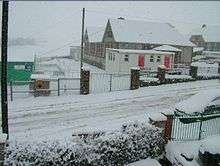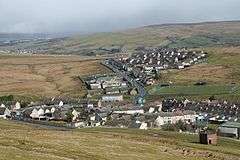Fochriw
Coordinates: 51°45′58″N 3°16′55″W / 51.766°N 3.282°W
Fochriw is a village located in Caerphilly County Borough, Wales. It was well known for its neighbouring collieries, which employed nearly the entire local population in the early 20th century. It lies within the historic county boundaries of Glamorgan. The village appears as the backdrop on the BBC Wales sitcom High Hopes credits.
History
Fochriw’s growth was germinated to a lesser extent by the Rhymney Iron Company’s requirement for ironstone, and to a greater extent by the Dowlais Ironworks’ requirement for coal, the quality of which was so good that it was used directly in the iron making process without the need for its conversion to coke. Over a period of about 130 years, the landscape changed from rural to industrial, and back to rural, as it is today. However, the latter changes did not take place until relatively recently when nearly all the remnants of the coal mining industry were removed from around the village. The memories of the industrial landmarks, or eyesores, that remained following the closure of the Fochriw and South Tunnel collieries are only retained by those of a certain age, and the younger generation no longer have the “experience” of living in a community which is centred on coal.
Location
Fochriw is a typical South Wales Valleys coal mining village that developed from its rural existence by the need for iron and coal during the 19th century. It is located on the north-east flank of Mynydd Fochriw at the head of the Bargoed Fach (now called the Darran) valley, approximately 5 miles (8.0 km) north of Bargoed, and 5 miles (8.0 km) south east of Merthyr Tydfil. The village straddles two ancient hamlets in the parish of Gelligaer, these being the Ysgwyddgwyn and Brithdir hamlets, the dividing line being the brook (Bargoed Fach) which flows in the bottom of the valley. The boundaries of these hamlets were walked by a number of parishioners of the parish on 24th day of May, 1750, and a document detailing the boundaries of each hamlet, namely Keven, Hengode, Garthgynyd, Ysgwyddgwyn, and Brithdecr (Brithdir) was produced, extracts of same are reproduced below.
Ysgwyddgwyn Hamlet It begins where Nant Goch goes to Bargoed by Pont Cradoc then along Nant Goch upwards to the stone standing on the Common opposite Mardy Bach house then from that stone directly westward along the old ditch to the Highway that leadeth from Pen yr Hrwl Ddu to Pen y Bryn Oie then along the way to Trosater Henla then to Three Great Stones standing in the Heath below Twyn y Wayn between Merthyr and Gellygaer then directly eastward to Bargoed River little below the way that leadeth from Keven y Brith
Brithdecr (Brithdir) Hamlet It begins where Bargoed River goes to Rhymney by Aberbargoed Bridge then along the River Bargoed upwards till it comes very near the way upon the Common that leadeth from Keven y Brith decr to Twyn y Wayn then directly eastwards to the three stones in the Heath below Twyn y Wayn between Merthyr and Gellygaer then directly to the E sid Twyn y Wayn then directly to Fynnon Gwellin then to the old water pond in Pantywayn Coal pits then directly to the spring head of a Brook called Nant y Glynon then to Pwll Elwch Uarc then to Carn y Clyndir or Mark Ycha then to Carn Helig then to Rhyd y Milwr on the River Rhymney then along the River Rhymney to Aberbargoed Bridge aforesaid.
The foregoing boundaries were perambulated the 24th day of May 1750 by George Parry Curate of Gellygaer, William Perrott Churchwarden, Edmond LLewelyn of Garthgynyd, George Williams of Carno, Henry Thomas of Brithdee, Thomas Lewis of Keven Bach, David Evans of Blaen Rhymney, Moses David of Pitwellt, Lewis Edwards of Ysgwyddgwyn and several others of the Parishioners of the said parish
Origin of the name
It was identified as Brohru Carn in the 12th century, and a reference to Fforch y Rhiw is made in the book Parish of Gelligaer by T.V. Davies, in the section dealing with Roman History and the route of Heol Adam. It states that “The holding called Fforch y Rhiw is mentioned in several Gelligaer leases of the 17th century. The name probably arises from a number of old tracks in the Brithdir Hamlet which tend to converge near Fochriw”.
It has also been known as Boch Rhiw Carn, Ffochreiw, Fochrhiw, Vochriw, Vochrhiw, and, currently, Fochriw. The interpretation of the name from an my original Fochriw family was Foch Y Rhiw Pentwyn Mawr which translates in English to : the cheek of the slope of the head hill (Pentwyn Mountain). This seems to describe the village's actual location.
In Ancient Times
By A.D. 75 the Romans had reached the flat plain where, within a mile or so of each other, the three rivers, Rhymney, Taff and Ely reach the sea, and had built there a wooden fort. Later this was rebuilt in stone and its remains can still be seen in patches at the base of the walls of Cardiff Castle. This was the principal centre of occupation of what was the old county of Glamorgan. Leaving at Cardiff a permanent garrison, the Romans pushed west and north. A Romanroad was made to Gelligaer as a connecting link between the forts of Cardiff and Brecon. In addition to a fort at Gelligaer another was eventually built at Penydarren. Thence the road ran through Pontsarn and Vaynor to Y Gaer, near Brecon. On an ordnance map one can trace the line of the Roman road on Gelligaer common, where it is known as Heol Adam. The Roman road from the fort at Gelligaer lies just west of Fochriw and Pant-y-Waun. It is said that the Romans marched 11 Roman miles a day and there was a rest post at Twyn-y-Waun which was 11 miles from the fort at Gelligaer. A Roman fort also exists at Pen-y-Darren which is located underneath the current site of Merthyr Town Football Club.
Education

The first school in the area was a National School at Pentwyn. It was opened in 1856 by the Gellygaer Charities which were left to the parish by Edward Lewis of Gilfach Bargoed in 1715.
The new infant school was opened in July 1910 and was attended for instruction by the scholars for the first time on the first Monday of September 1910. In April 1911 a half acre of land adjacent to the existing school was bought for £20. It was not until September 1912 that a letter was written to the building committee of the County Council recommending that a new school be built.
On 1 April 1971 both Infants and Junior schools combined under one Head Teacher to become Fochriw Primary School. A Nursery was opened at Plantation Terrace in 1973.
See also
Bibliography
- Evans, Marion, (1994), A Portrait of Rhymney with cameos of Pontlottyn, Tafarnaubach, Princetown, Abertysswg and Fochriw, volume 1. Old Bakehouse Publications. ISBN 1-874538-40-9.
- Evans, Marion, (1995), A Portrait of Rhymney with cameos of Pontlottyn, Tafarnaubach, Princetown, Abertysswg and Fochriw, volume 2. Old Bakehouse Publications. ISBN 1-874538-70-0.
- Evans, Marion, (1996), A Portrait of Rhymney with cameos of Pontlottyn, Tafarnaubach, Princetown, Abertysswg and Fochriw, volume 3. Old Bakehouse Publications. ISBN 1-874538-41-7.
- Evans, Marion, (1998), A Portrait of Rhymney with cameos of Pontlottyn, Tafarnaubach, Princetown, Abertysswg and Fochriw, volume 4. Old Bakehouse Publications. ISBN 1-874538-02-6.
- Evans, Marion, (2009), A Portrait of Rhymney with cameos of Pontlottyn, Tafarnaubach, Princetown, Abertysswg and Fochriw, volume 5. Old Bakehouse Publications. ISBN 978-1-905967-20-9.
- Price, Peter, (1996),A History of Fochriw in Photographs with Pentwyn and Pantywaun Volume 1. Old Bakehouse Publications. ISBN 1-874538-11-5
- Price, Peter, (1997),A History of Fochriw in Photographs with Pentwyn and Pantywaun Volume 2. Old Bakehouse Publications. ISBN 1-874538-56-5
- Price, Peter & Coggan, Ifor, (2011) A History of the Darran Valley in Photographs, Volume 1.
- Coggan, Ifor, (2012), A History of Coal Mining in the Darran Valley
External links
- Ifor Coggan (2007). "Fochriw History - A history of a South Wales mining village". Retrieved 2007-09-25.
- "Fochriw Primary School". Caerphilly County Borough Council. Archived from the original on 2007-07-08. Retrieved 2007-09-25.
www.cprw.org.uk/landscapes/gelligaer.htm Gelligaer Common, an historic landscape


